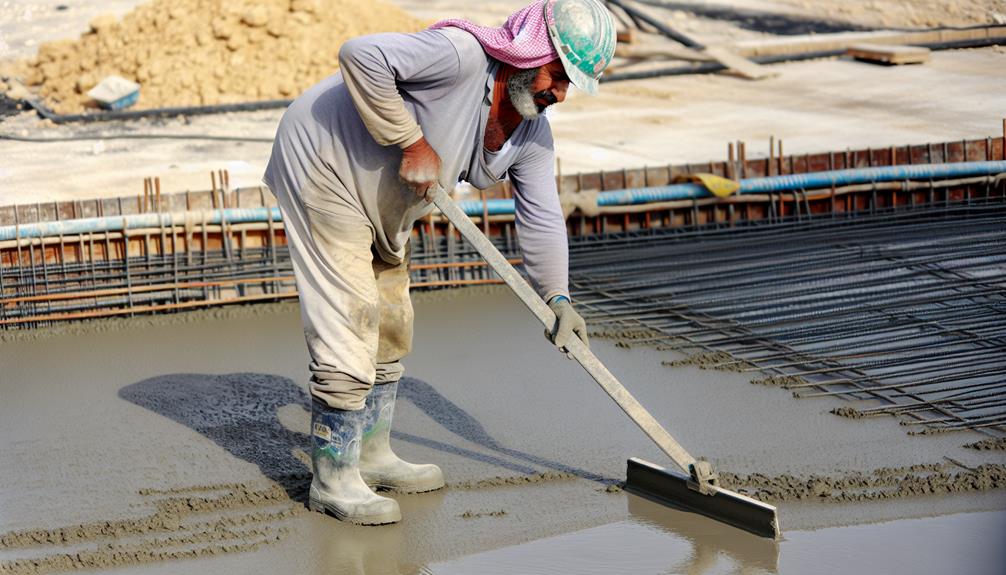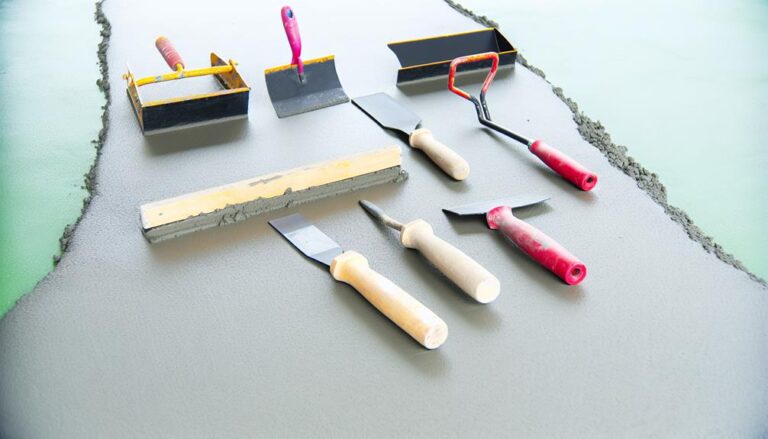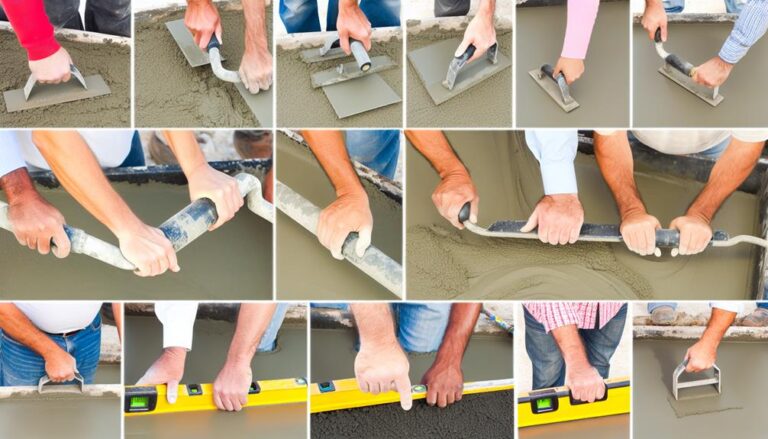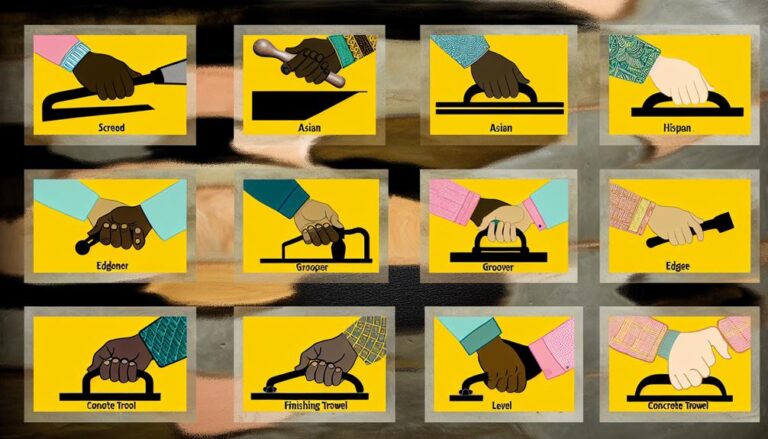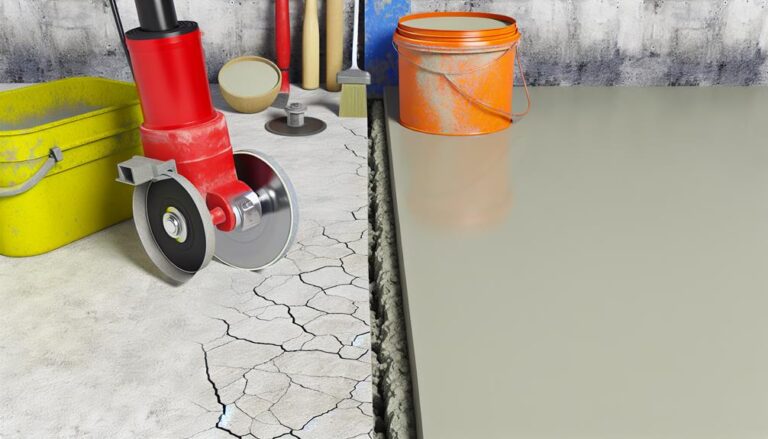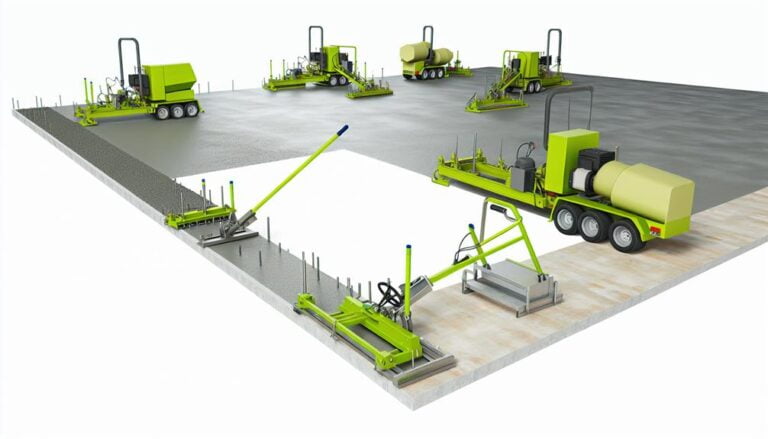How-to Guide: Mastering Concrete Leveling Techniques
Mastering concrete leveling starts with understanding the basics, from ground preparation to choosing the right tools. You'll work with leveling compounds, trowels, and levels, ensuring your mix design's strength, aggregate choice, and water-to-cement ratio. Pouring in small sections, spreading evenly, and allowing proper curing time avoids common issues. Your equipment must be maintained and cleaned regularly to ensure a professional finish. Essentially, using the correct leveling technique on a properly prepared surface, with the right equipment, will see your skill improving quickly. Stick around, there's more to uncover about mastering this art.
Understanding Concrete Leveling Basics
Before you can master concrete leveling, you've got to grasp the basic principles that govern this essential construction technique. Your first step? Understanding what concrete leveling is. In layman's terms, it's the process of correcting an uneven concrete surface by altering the foundation that it sits on. This technique is vital for preventing trips and falls in both residential and commercial settings.
You should also get familiar with the tools of the trade. You'll need a leveling compound, a trowel, and a long level. The compound, a type of high-strength concrete, is used to fill in low areas. Your trowel is for spreading this compound, while the level ensures your work is even.
Don't forget the importance of safety! Always wear protective gear, such as goggles and gloves. Concrete can cause serious burns when it comes into contact with skin. Furthermore, the dust it produces can harm your eyes and respiratory system.
Importance of Ground Preparation
Ground preparation is a crucial step in the concrete leveling process and cannot be overlooked if you want a smooth and durable finish. Without proper ground preparation, issues like uneven surfaces and potential cracks may arise over time. Therefore, understanding the importance of this stage and how to execute it correctly is essential.
To prioritize ground preparation, consider the following reasons:
- Ensures a flat surface, crucial for achieving a smooth finish.
- Helps prevent problems such as cracking and sinking.
- Provides a solid base for the concrete, enhancing its longevity.
- Aids in proper drainage, avoiding water accumulation that can damage the concrete.
To execute ground preparation effectively, start by removing any debris and assessing the soil condition. Based on your assessment, you may need to add gravel for better drainage or compact the soil for improved solidity. By following these steps, you can ensure that your concrete leveling project starts on the right foot.
Choosing the Right Leveling Equipment
Once you've thoroughly prepared the ground, your next task is to select the appropriate leveling equipment for your concrete project. This choice is pivotal to the success of your job as it impacts the smoothness and flatness of the final surface.
Firstly, consider the size of your project. For smaller areas, a hand trowel or a bull float may suffice. These tools are perfect for spreading and smoothing out the concrete mix. They're also budget-friendly, making them ideal for DIY enthusiasts or one-time projects.
However, for larger spaces or commercial projects, you'll need something more robust. A power trowel, for instance, can cover a large area quickly and efficiently. This machine has rotating blades that smooth and level the concrete surface, saving you time and effort.
Also, don't forget about screeds. These tools come in various types, including laser screeds for precision leveling and vibrating screeds for compacting and leveling the concrete in one step.
Lastly, remember that the right equipment can only do so much. It's your skill and understanding of concrete leveling techniques that will ultimately determine the quality of the finished surface. So, ensure you're well-versed in using your chosen tools before you start.
Mix Design for Concrete Leveling
Understanding the right mix design for concrete leveling is crucial to achieving a durable and level surface. The mix design you choose will directly affect the workability, strength, and durability of your concrete.
Here are some key components to consider when designing your mix:
- Cement: It's the binder in your mix. The amount you use will directly affect the strength and durability of your concrete. Make sure you're using the right type and amount for your project.
- Aggregate: This forms the bulk of your mix. You'll need to choose the right size and type of aggregate to ensure a smooth, level surface.
- Water: This is what activates the cement and makes your mix workable. Too much water can weaken your concrete, so you must be careful with your water-to-cement ratio.
- Admixtures: These are added to alter the properties of your mix. They can improve workability, slow down or speed up setting time, and increase durability.
Techniques for Pouring Concrete
After you've perfected your mix design, it's time to get hands-on with pouring the concrete, a step that requires specific techniques for optimal results.
First, ensure your work area is prepped. You'll need to set up your forms, ensuring they're level and secure. If you're pouring a slab, it's essential that the ground is compacted and level.
Next, it's time to pour. Start at the lowest point and work your way up, if applicable. Pour the concrete in small, manageable sections. This allows you to focus on one area at a time, ensuring it's level before moving onto the next.
Use a shovel or a rake to spread the concrete. This helps achieve an even distribution, reducing the risk of weak spots. It also helps to push the concrete into corners and edges, ensuring full coverage.
Avoid overworking the concrete, as this can lead to water separation and weaken the mix. Instead, aim for a smooth, even surface.
Lastly, don't rush the process. Concrete takes time to set, and rushing can compromise the quality of your work. Follow the manufacturer's instructions for curing time, and don't forget to keep the concrete moist to prevent cracking.
Proper Use of Concrete Leveling Tools
To achieve a smooth and level concrete surface, you'll often need to use specific leveling tools correctly. These tools not only help you achieve a professional-looking finish but also ensure the durability and longevity of your concrete work.
Some commonly used concrete leveling tools include:
- Concrete trowels: You'll use these to smooth out the concrete surface. Always glide the trowel across the surface in sweeping motions for a seamless finish.
- Bull floats: These tools are excellent for leveling out large surface areas. Ensure you're using a back-and-forth motion to spread the concrete evenly.
- Edgers: These help create clean edges around your concrete. Always run the edger along the edges of your concrete for a neat finish.
- Screeds: You'll use these to level the top of your concrete. Remember to pull the screed across the surface in a sawing motion for a level finish.
Troubleshooting Common Leveling Issues
Despite your best efforts, you might encounter a few common leveling issues when working with concrete. Don't worry, it's not just you; even seasoned pros can run into these problems.
One common issue is uneven leveling. You've likely seen this when one side of your concrete slab is higher than the other. This usually happens when you've used too much or too little concrete mix. To fix this, you'll need to add or remove concrete until you achieve a uniform level.
Another common problem is the formation of air bubbles or 'honeycombing'. This typically occurs when the concrete hasn't been properly vibrated or compacted. You can address this by ensuring you vibrate your concrete thoroughly during the pouring process.
Lastly, you might face issues with the concrete not settling properly, causing it to crack or crumble. This often happens when the concrete mix isn't right, or when it's exposed to extreme weather conditions. To combat this, always ensure your mix is balanced and protect your work from harsh elements.
Maintenance Tips for Leveling Equipment
Just as important as troubleshooting common leveling issues is maintaining your leveling equipment to prevent these issues from occurring in the first place. Regular maintenance not only extends the lifespan of your tools but it also ensures they operate at their optimal efficiency.
Here are four easy-to-follow maintenance tips for your leveling equipment:
- Clean After Use: Always clean your tools immediately after use. This prevents the buildup of concrete residue, which can impair the functionality of your tools over time.
- Regular Inspections: Make it a habit to inspect your tools before and after use. Look for signs of wear and tear, and address them promptly.
- Proper Storage: Store your tools in a dry, clean place. Moisture can lead to rusting, which can severely damage your tools.
- Routine Servicing: Have your tools serviced regularly by a professional. This ensures that any underlying issues are identified and fixed before they become bigger problems.
Frequently Asked Questions
What Safety Measures Should Be Taken While Handling Concrete Leveling Equipment?
When handling concrete leveling equipment, you've got to prioritize safety. Always wear protective gear, including gloves, safety glasses, and sturdy footwear.
Don't forget, it's crucial to ensure the equipment's in good working order before you start. Regularly inspect and maintain it. Make sure you're using it correctly, too.
Don't underestimate the importance of training. In the end, it's all about keeping you safe while you master the art of concrete leveling.
How Much Time Does It Typically Take for Leveled Concrete to Dry Completely?
When you're working with leveled concrete, drying time can depend on various factors. Typically, it takes about 24 to 48 hours for basic set up. However, for it to completely dry and reach optimal strength, you're looking at a period of about 28 days.
Keep in mind, this can vary depending on the type of concrete mix, humidity, and temperature. It's always best to wait and ensure it's fully dried before use.
What Are the Environmental Impacts of Concrete Leveling?
Concrete leveling has several environmental impacts. It reduces landfill waste by repairing instead of replacing concrete.
However, it can use chemicals that aren't eco-friendly. If you're concerned about this, you can opt for eco-conscious companies that use greener methods.
Plus, it's less destructive to land and surrounding plants than full replacement. But remember, it's still a construction process, so it's not entirely without impact.
Always research and choose responsibly.
How Does Weather or Temperature Affect the Concrete Leveling Process?
Weather or temperature greatly affect your concrete leveling process. In hot weather, concrete can dry too fast, causing it to crack. On the other hand, if it's too cold, it may not set properly.
It's best to work in moderate temperatures where the concrete can cure at a steady rate. Always remember to adjust your work methods according to the weather conditions to ensure the longevity and durability of your concrete leveling work.
Can Concrete Leveling Be a DIY Project or Does It Require Professional Assistance?
You can certainly tackle concrete leveling as a DIY project, but it's not easy. It requires specialized tools and a solid understanding of the materials and processes involved.
Mistakes could lead to uneven surfaces or structural issues. If you're not fully confident in your skills, it's best to hire a professional. They'll have the expertise to ensure the job's done right, saving you potential headaches down the road.
Conclusion
And there you have it, folks! You've now got the nuts and bolts of concrete leveling under your belt. From prepping your ground to pouring the mix, you're ready to tackle any bumps in the road.
Remember, practice makes perfect. So, don't let a few cracks discourage you. With your newfound knowledge and a bit of elbow grease, you'll be leveling concrete like a pro in no time.
Keep your tools sharp and your spirit sharper!
